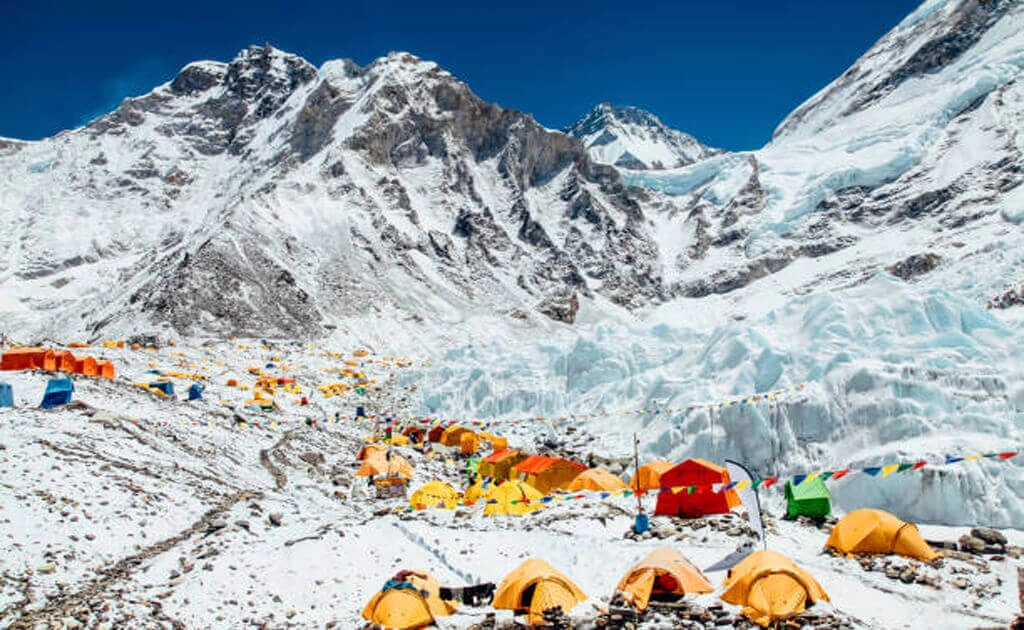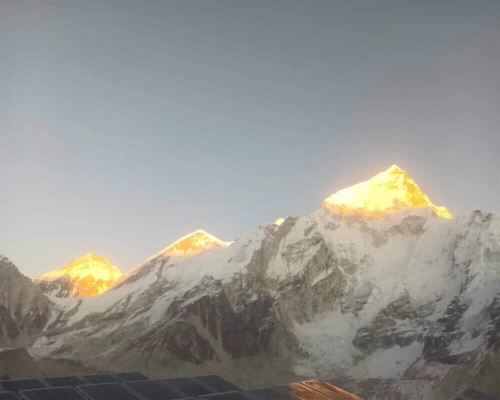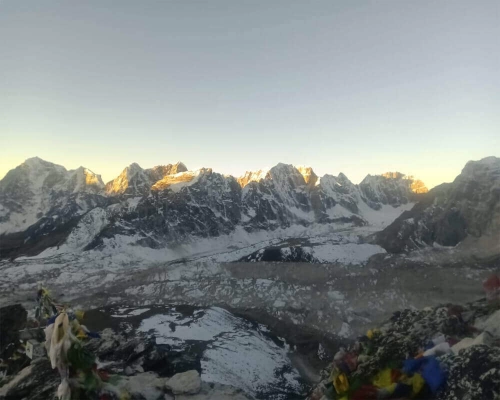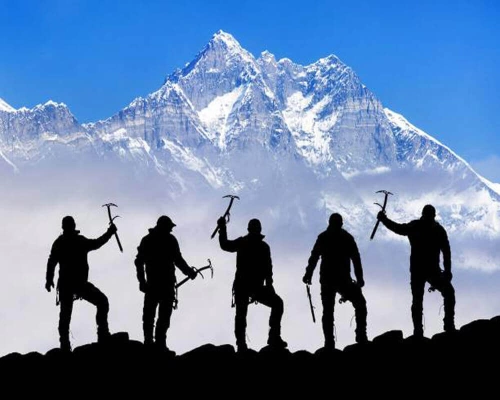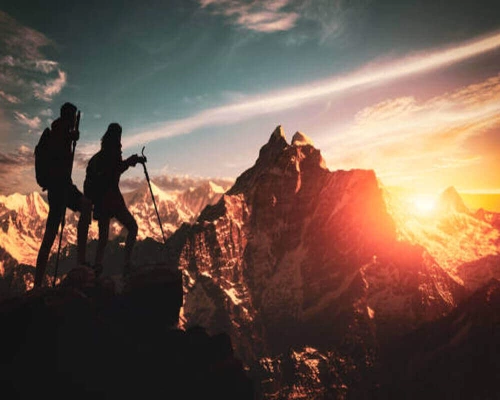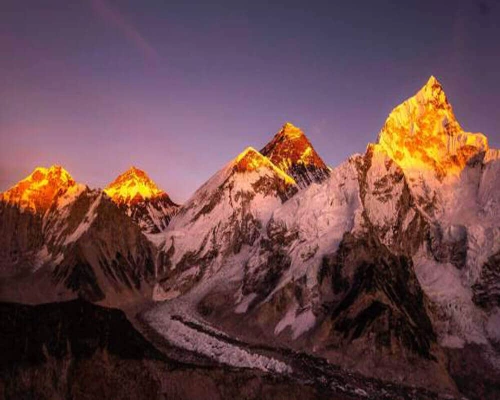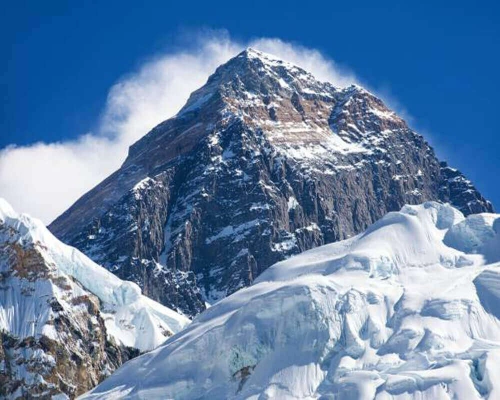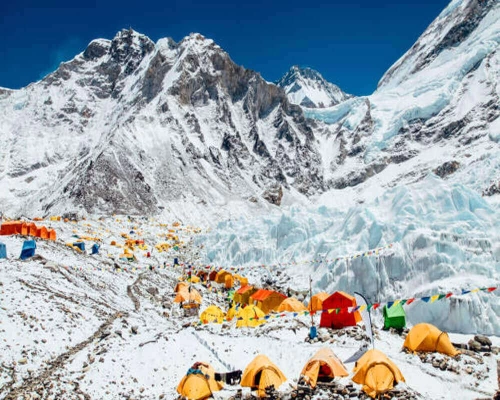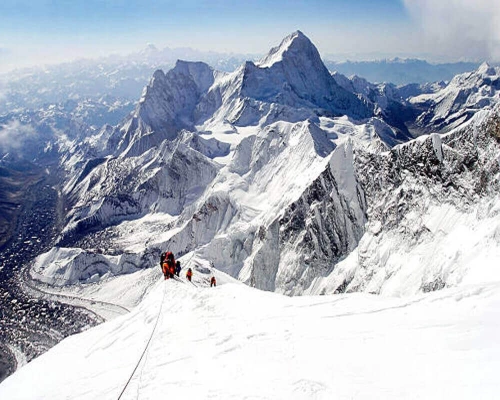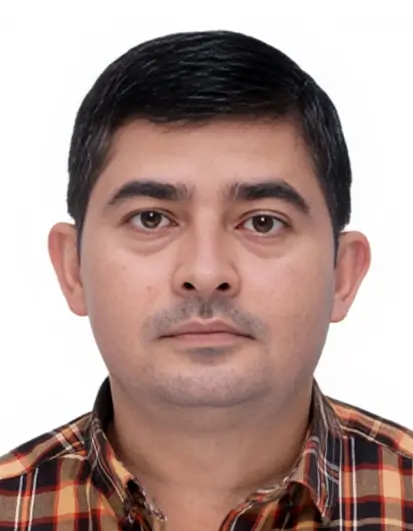Add-ons:
Combine Lobuche East climbing for acclimatization: Most of the Everest expedition itinerary out there combines climbing Lobuche East Peak as their climbing rotation. Our itinerary does not have that, which also lowers our expedition cost. However, if you can afford it, we recommend adding Lobuche East Peak climbing to your Mount Everest expedition itinerary.
Trek extension: If you do not want to spend much time at the base camp acclimatizing, you can extend your trekking itinerary to Gokyo Valley and three passes.
Climb Everest and Lhotse together: Lhotse is the fourth-highest mountain in the world. It is connected to Everest by the South Col. You will climb to South Col during the Everest expedition. It is a fantastic opportunity to conquer two notable mountains in one expedition.
Helicopter flights: You can include helicopter flights from Kathmandu to Lukla, Kathmandu to Everest Base Camp, and Everest Base Camp to Lukla or Kathmandu.
Additional Sherpa guide: We provide enough support in our Everest expedition cost. But you can also hire an additional Sherpa guide for more comfort and safety during climbing.
Luxury trek: Upgrade basic lodges to premium lodges during trekking for better amenities and comfort.
Base camp facilities with Welcome Nepal Treks
As you will spend most of your time at the Everest Base Camp, the services here matter greatly. We make sure you have access to all essential services, including a reliable team of doctors and trained kitchen staff at the base camp.
We will provide all tents, interiors, fuel, equipment, and other things. Our group shares washroom, dining, and kitchen tents. However, every member will have a separate sleeping tent with a comfortable mattress, heating blanket, pillow, etc.
We ensure our tents and equipment are well-maintained and in good condition. It is important that you and the rest of the climbing party have a stress-free time at the base camp so that you can perform better on the mountain. So, we have thoughtfully planned every little detail.
For instance, we use high-grade tents that are insulated and fully carpeted. Likewise, we have a full entertainment arrangement, from board games and music to a projector for movies.
Not only that, we also accept personal requests. Let us know when booking if you want anything at the base camp.
Everest expedition preparation
We cannot overemphasize the importance of physical, mental, technical, altitude, logistical, and packing preparations for the Everest expedition.
Yes, there is a lot to do before you even hit the trails, and why wouldn't it be when the Everest expedition is the greatest human expedition on Earth?
We will take care of meticulously crafting the Everest expedition itinerary and logistics exclusively for you. However, you have to be responsible for getting yourself ready for the trip.
Our team will be with you even before you land in Kathmandu, providing the right direction for getting physically and mentally ready, suggesting climbing gear, and answering your questions.
Physical fitness for Everest expedition:
If you want to climb Mt. Everest, your fitness has to be exceptional. To do that, you can start by climbing small peaks and mountains in Nepal and other countries.
Previous climbing experience is a must to climb any 8,000ers in Nepal, including Everest. The more you climb, the better your climbing skill will get, which will be a huge help during the Everest expedition.
Likewise, you can join training programs designed to prepare you physically and mentally for mountains like Everest. Focus on strength training, endurance training, and aerobic and anaerobic exercises.
Mental preparation for Everest expedition:
While you are physically training, your mind will also evolve and get used to a lot of pressure on your body. However, this is not enough. Climbing Mt. Everest is equally mentally challenging as physically.
You have to fight your thoughts every second above 6,000 meters. Not only that, but you have to push yourself against all the odds. So, mental preparation cannot be overlooked.
The more you feel knowledgeable and confident in your climbing abilities, the better your mind will perform during the Everest expedition.
So, practice climbing, hone your climbing technique, get experience on smaller mountains, learn about the Everest climbing route, and practice a positive mindset and attitude.
Technical skills for Everest expedition:
Everest is a technical mountain. It involves crossing huge crevasses, icefalls, ice walls, rock slabs, steep snowy slopes, and whatnot. Likewise, you will use several climbing gear throughout the expedition.
You can hone your technical climbing skills by climbing smaller mountains with and without technical difficulties and participating in special programs that are designed to provide you with technical climbing knowledge.
Altitude training:
The Everest expedition takes you to the highest point on Earth. You will go way beyond the air pressure that humans are used to, therefore risking yourself to acute mountain sickness and other complications.
Our Everest expedition itinerary has ample acclimatization days before you reach the summit, which drastically decreases the risks of altitude sickness. However, you also need previous high-altitude experience.
You can get that by hiking, trekking, and climbing. Likewise, there are also altitude training programs in many cities around the world that you can join. Your body has to learn to adapt to low oxygen levels.
Gear and equipment:
Climbing Mount Everest requires a lot of gear. You have to wear proper clothes, carry all essential supplies, and use special tools like crampons, ropes, ladder, ax, harness, carabiners, jumar, tape sling, etc.
If you are a seasoned climber, you may have most of these tools. However, if you don't, no need to worry. We personally provide most of the climbing tools to our climbers.
Likewise, you can also rent many of them at a very minimal cost in Kathmandu. We have made a comprehensive packing list for Everest, which is below. You can use it to pack for the expedition.
Logistics and planning:
We take care of logistics and planning for the Everest expedition. You can share your requirements with us. We will handle all the details.
Everest expedition via South Col route:
- Everest Base Camp: 5,364 m/ 17,598 ft
- Everest Base Camp is the permanent base camp during the expedition. You will spend the longest time here resting, practicing climbing techniques, and doing acclimatization rotations. The EBC is a moving glacier.
- It is located at the foot of the Khumbu Glacier, which flows down from the Western Cwm. The base camp terrain is rugged and steep, with rocks, moraines, and glaciers.
- Our base camp team will set up the tents and essentials before you arrive there. They will welcome you to your new home for the next couple of weeks. During your time at the base camp, you will rest, hone your climbing skills, and do rotations on the Khumbu Icefall.
- Camp I: 6,065 m/ ft
- Camp I is on the Khumbu Icefall on a rocky outcrop. It is one of the most technical sections of Mount Everest. The icefall is 2,000 ft moving ice with deep chasms, ice sera, and torrential slides off.
- During your time at the Everest Base Camp, you will practice crossing the icefall, so you will be all ready and confident before moving to Camp I. You will be supported by your Sherpa guide team.
- Camp II: 6,492 m/21,299 ft
- Camp II is above the Western Cwm. It is built on a broad ridge along a moraine at the lower part of the west edge. It is a safe area protected by the huge face of Lhotse. The route from Camp I to Camp II is steep. It goes along ice cliffs and crosses deep crevasses.
- Camp II is our second primary camp after the base camp. We will have almost everything here to support the further expedition. The support team will set up the kitchen, dining, washroom, and sleeping tents here. All climbers will get separate sleeping tents.
- You will spend a good number of days at Camp I acclimatizing before the summit push.
- Camp III: 7,470 m/24,500 ft
- Camp III is above the Lhotse Face. To reach here, you will climb the Lhotse Face. The route is tricky, and high elevation makes climbing more challenging.
- We have to do our best not to use supplemental oxygen till this point to train our body and mind for further elevation gain. However, if needed, we will be equipped with ample oxygen. The route is unstable and has steep, icy slopes of 30-40 degrees.
- We will use fixed ropes to climb. We will gain almost 1000 meters from Camp II to Camp III. It will be our second temporary camp, where we will spend a few nights before climbing to Camp IV.
- South Col (Camp IV): 8,000 m/26,300 ft
- Camp IV, or South Col, is our last camp before the Mount Everest summit. It is situated on a narrow saddle between Everest and Lhotse. The Everest summit is on the north, and the Lhotse is on the south.
- In our experience, mountaineers do not need extra oxygen support till Camp IV. The route from Camp III navigates through two rock sections. You will cross the Yellow Band, which is the interlayer of marble, phyllite, and schist rock.
- Likewise, the second section is the Geneva Spur, which is an anvil-shaped rib of black stone. The guides will fix the entire route with the ropes for a safe climb.
- Summit: 8,8489 m/29,032 ft (1 hour or less)
We can reach the Everest summit in approximately one hour of climbing from Camp IV. On the summit day, we will begin climbing at dawn, using our headlights. We will start climbing around 1:00 AM.
The Sherpa guides will fix the rope up to the Balcony, a small platform at 8,400 meters (27,500 ft). From here, the route goes up the southeast ridge that leads to the infamous Hillary Step, a 12-meter (40-foot) rock face.
Climbing is demanding because of elevation, narrow path, high wind, and cold. After this point comes the south summit and the central panel. From here, we will climb to the true summit of Mt. Everest, a moderate snow slope.
Tentative acclimatization schedule
- Nine days of trekking to the Everest Base Camp, gradually gaining elevation
- Lukla and spend night in Phakding
- Two nights in Namche Bazaar
- Tengboche
- Two nights in Dingboche
- Lobuche
- Gorak Shep
- Everest Base Camp
- Acclimatization rotation (the rotation may differ as per the need of the climbers)
- Climb Khumbu Icefall to reach Camp I and descend
- Climb to Camp II and descend
- Climb to Camp II and spend a night
- Touch Camp III and descend to Camp II for a night stay
- Descend to the base camp
- Summit push
- Climb to Camp I
- Climb to Camp II
- Climb to Camp III
- Climb to Camp IV
- Summit push and descend to Camp II
- Descend to base camp
Is the Mount Everest Expedition right for you?
Mount Everest Expedition takes you to a place where no human or any living organism is found. You have to be aware and understand what you are stepping into.
The climbing conditions are extreme even during the best time of the year. The exposure to sun, cold, and wind is profound.
It costs a lot of money to climb Mt. Everest. You also need to keep aside significant emergency funds.
The expedition is strenuous and will break you if you are not determined and ready to push yourself beyond your limits.
The facilities are limited but decent till Everest Base Camp. From here onwards, there is nothing but the void of the Himalayas and your willpower.
What is included in our Everest expedition price?
The Everest expedition cost covers transportation, accommodation, meals, permits, Sherpa guides, porters, company service charges, and necessary taxes. All the services will be given as per our itinerary.
We have shared more about our package includes below:
- Our Sherpa guide and climber ratio is 1:1, so each climber will have one Sherpa guide who has summited Mount Everest at least once.
- One veteran Sherpa guide who has summited Everest at least five times before and is well aware of the route.
- Adequate base camp staff, including kitchen and doctor team.
- High camp porters carry tents, food, and other essentials.
- A weather guy who will keep an eye on changing weather patterns and inform the climbing party as they ascend to the higher camp.
- Sleeping tent with a comfortable mattress, electric heating pad, warm blanket, and soft pillow.
- All tents will be lit by solar power. You can charge your devices as well.
- Delicious meals cooked by our professional chef at the base camp.
- Essential climbing gear, toilet bags (must be carried off the mountains by the individuals), and satellite phones.
- CE-certified oxygen cylinders with British top-out mask and regulator.
- Internet connection with a nominal charge.
- Why join our Mount Everest Expedition 2025 and 2026?
- A Nepalese UIAGM/IFMGA expedition leader
- Supported by the best Sherpa team
- 1:1 Sherpa guide to client ratio
- Dedicated expedition manager
- Eight oxygen bottles for each climber and three for their Sherpas
- Premium base camp service
- Many top-notch complimentary climbing gear from our archive to use during the expedition
- Satellite phones and walkie-talkies for constant communication between high camps, base camp, and city office
- Base camp doctor and dedicated weather support team
- Private chef and kitchen staff
- Sleeping tents equipped with soft mattress, blanket, pillow, electric heating pad, charging slots, light, carper, etc
Altitude Sickness
Altitude sickness is one of the primary concerns of the Everest expedition. It happens when you ascend quickly, and your body fails to adjust to the elevation. Therefore, ascending slowly is the key to avoiding altitude sickness.
Note that anyone can suffer from altitude sickness regardless of age, experience, and fitness. So, we highly suggest climbers not take altitude sickness lightly and follow our acclimatization plan and preventive measures.
There are three conditions of altitude sickness. We have talked about them below:
Mild/moderate altitude sickness (acute mountain sickness - AMS):
It is the start of altitude sickness. You will see symptoms like headache, vomiting, dizziness, insomnia, difficulty breathing, uneasiness, fatigue, and loss of appetite.
These symptoms are visible within 6 to 12 hours of ascent if your body is not acclimatizing. As it is the early signs of altitude sickness, it can be cured with rest, first aid, and descending to a lower elevation.
High altitude cerebral edema (HACE):
High-altitude cerebral edema is a severe form of altitude sickness. It happens when fluid accumulates in the brain, which causes swelling and increased intracranial pressure.
Symptoms: Difficulty walking, severe headaches, confusion, loss of consciousness, altered mental status, hallucinations, and seizures.
Preventive measures: Immediate medical attention and fast descent.
High altitude pulmonary edema (HAPE):
High-altitude pulmonary edema is the worst case of altitude sickness. It happens when fluid accumulates in the lungs, which impairs oxygen flow in the body and leads to respiratory distress.
Symptoms: Persistent cough with pink or frothy sputum, severe shortness of breath, rapid heartbeat, chest tightness, and cyanosis (blue or gray discoloration of the skin and lips).
Preventive measures: Quick descent with supplemental oxygen support and immediate treatment
When Mount Everest is climbed?
The best time to climb Mt. Everest is in April and May. This period has stable weather and climate. The risks of avalanches, snow storms, rock falls, etc, are low.
Likewise, the glaciers are sturdy, and the opening of crevasses is low. You will also get many summit windows, increasing the chances of a successful assessment.
Late September to November is another climbing season. However, not many people climb Everest during this time. The weather and glaciers are stable. However, there can be unexpected movement in the glacier.
Food & Drinks
In Kathmandu, you will get breakfast. During trekking, we will provide three meals a day- breakfast, lunch, and dinner. Likewise, while climbing, you will get three meals, including daily, additional snacks and beverages.
There is a wide variety of food options in Kathmandu. You can dine as you wish. While trekking to Everest Base Camp, the food option is limited but decent. Similarly, during climbing, our chef will cook delicious meals for you.
During trekking, you will have options such as dal bhat, thukpa, momo, thenduk, chowmin, fried rice, curry, chapati, Tibetan bread, sandwiches, pasta, pizza, etc. Likewise, we will curate the climbing menu, keeping the nutritional and energy needs of the climbers.
All the meals will be rich in protein, fat, carbohydrates, and other nutrients. If you have any dietary restrictions, inform us ahead of time. There will be no issue with drinking water, and many kinds of teas, coffees, and soft drinks will be available, too.
Accommodation
In Kathmandu, you will spend nights in a three-star hotel. During trekking, you will share a room with one more trekker. Single rooms cost extra money. During climbing, you will have a single sleeping tent at the base camp and a twin-shared tent at higher camps.
All accommodations will be provided as per our itinerary. In Kathmandu, you will have access to all modern amenities. However, during trekking, the services get limited, and you have to pay a few bucks for most of them, such as hot showers, charging, WiFi, etc.
All services are included in the package cost at the base camp and above. We use solar power to light the tents and charge our devices. Carry a few battery backups or power banks. WiFi at the base camp will be limited. There is no network at higher camps, so we use Wakitalki and Satellite phones.
Supplement oxygen
Every climber will get 8 oxygen cylinders for the expedition. It is enough to reach the summit and return. Sherpa guides and porters will also be equipped with their own oxygen tanks. Our support team carries the oxygen cylinder to the higher camp.
During the summit push, we use a 2-liter oxygen cylinder, which allows us to climb efficiently. You can also purchase extra oxygen cylinders and hire porters to carry them for you.
Communication
At the Everest Base Camp, you may find a network to contact your family occasionally. A Nepali sim called NCELL provides better network coverage but is unreliable. We use satellite phones and walkie-talkies at higher camps to stay connected with the base camp. They will monitor the weather and keep us updated.
Travel Insurance
Travel insurance is mandatory to join the Everest expedition. It must cover medical expenses and helicopter evacuation. Currently, no company in Nepal provides comprehensive travel insurance for Mt. Everest expedition, so you have to purchase it in your country. Bring the documents with you and submit them to use before the journey starts.
Packing list
Head & Hand
Sun Cap
Wool/Fleece Hat
Balaclava
Hand Warmer
Neck Gaiter/High Neck
Lightweight Synthetic Liner Glove
Wind Stopper Fleece Gloves
Summit Gloves Heavy Gloves (Mitten)
Upper Body
Short-Sleeved Shirts/T-shirts
Lightweight Top/Thermo Coat
Midweight Top
Heavyweight Top
Synthetic or Fleece Jacket
Down Insulated Jacket
Windproof Jacket
Gore-Tex Jacket
Lower Body
Underwear
Lightweight Long Underpants
Midweight Long Underpants
Heavyweight Long Underpants
Trekking Pants
Down/Synthetic Insulated Pants
Gore-Tex Pants
Trekking & Climbing Socks
Summit Socks
Technical Devices/Climbing Gears (UIAA/CE Tested)
Climbing Helmet
Headlamp with Spare Batteries (Petzl/BD)
Summit Down Suits (Kailas/Marmot/The North Face)
Ice Axe Semi-technical
Harness
Carabiners (Both Lock & Unlock)
Ascenders/Jumar
Belay Device (ATC Guide/Figure of 8)
Assistant Rope
Tape Sling
Ice Screw
Summit Boot/One Sports Alpine Boot/G2SM
Crampons
2 Sleeping Bag: -30 +C to -40 +C
Thermarest Inflatable Mattress
Thermarest Cell Foam Mattress
Sun/Glacier Glasses UV Protection
Snow Goggle UV Protection
Extendable Trekking Poles (BD Alpine Flz)
First Aid Kit
Toiletries
Miscellaneous
Swiss Knife
Sandals
Lightweight Hiking/Trekking Boots
Camp Booties
Rucksacks (45 - 55 Ltr.)
2 Duffel Bag
Water Bottles
Thermos/Flask
Pee Bottle
Pack Towel
Umbrella/RainCoat
Spare batteries
Waterproof Stuff Sacks
Satellite Phone (if possible)
Solar chargeable power bank (optional)
Journal/Pen
Book/Board Game
Bars & Snacks
Travel Documents:
